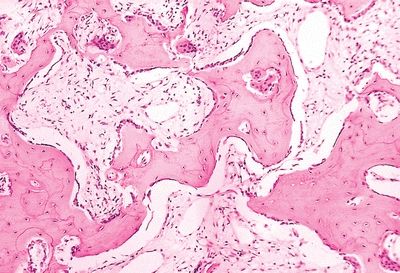QUESTION 7.2
A. Abnormal mineralization of growth plate
B. Fragmentation of growth plate
C. Increased density of bone
D. Premature fusion of growth plate
E. Thinning of bone trabeculae
3. A patient under treatment with hemodialysis for chronic renal failure undergoes a bone biopsy. The biopsy reveals increased osteoclastic activity resulting in the microscopic pattern shown in this picture. Which of the following radiographic presentations would be most consistent with this patient’s history and biopsy findings?

QUESTION 7.3
A. Bilateral symmetric stress fractures of metatarsal bones
B. Bowing of the tibia with thickening of the cortex and coarsening of trabecular architecture
C. Erlenmeyer flask deformity, with constriction of diaphysis and flaring of metaphysis
D. Erosion of phalangeal tufts and subperiosteal resorption of radial side of phalanges
E. Expansion of distal end of the femur with a bag-of-popcorn appearance
F. Flattening of vertebral bodies with widening and swelling of intervertebral discs
4. A bone biopsy shows the features seen in this photomicrograph. Which of the following is suspected to cause this disease?

QUESTION 7.4
A. Genetic alteration
B. Metabolic disturbance
C. Metal toxicity
D. Repetitive trauma
E. Viral infection
5. A 20-year-old football player undergoes excision of a recently developed mass in the flexor aspect of the right arm. There is a history of recent trauma. H&E sections show a central region of highly cellular and pleomorphic mesenchymal tissue, surrounded by osteoid deposition and a peripheral rim of trabecular bone. These features are consistent with:
A. Extraneous osteosarcoma
B. Juxtacortical osteosarcoma
C. Myositis ossificans
D. Nodular fasciitis
E. Proliferative fasciitis
6. Which of the following statements on infectious osteomyelitis is correct?
A. Bacterial biofilms play a key role in chronic osteomyelitis.
B. Brodie abscess is an acute form of osteomyelitis.
C. Hematogenous osteomyelitis is most common in adults.
D. Mortality rate is approximately 50%.
E. Chronic osteomyelitis develops in fewer than 5% of cases.
Stay updated, free articles. Join our Telegram channel

Full access? Get Clinical Tree


